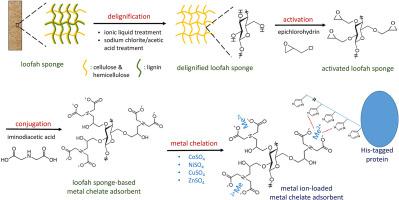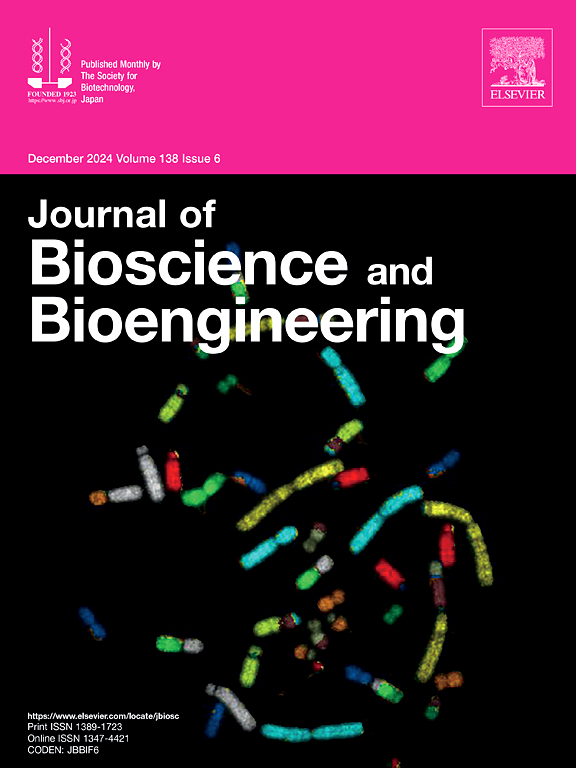Effect of delignification on the adsorption of loofah sponge-based immobilized metal affinity chromatography adsorbent for His-tagged trehalose synthase
IF 2.9
4区 生物学
Q3 BIOTECHNOLOGY & APPLIED MICROBIOLOGY
引用次数: 0
Abstract
The effect of delignification on the adsorption capacity of loofah sponge-based immobilized metal affinity chromatography adsorbents was investigated with recombinant His-tagged trehalose synthase as the model protein. Pretreatments with [EMIM][Ac] ionic liquid at 80 °C for 5 h and with sodium chlorite/acetic acid at 80 °C for 2 h were found effective for the removal of lignin, leading to a loss in biomass of 15.7% and 25.2%, respectively. Upon delignification, the metal chelating capacities of the loofah sponge-based adsorbents prepared with 5-h ionic liquid pretreatment (712 ± 82 μmole Cu(II)/g) and with 2-h sodium chlorite/acetic acid pretreatment (1012 ± 18 μmole Cu(II)/g) were 38% and 97% higher than that of the control (514 ± 55 μmole Cu(II)/g), adsorbent prepared with untreated loofah sponge, respectively. Results of protein adsorption study indicated that the Co(II)-loaded adsorbent prepared with 2-h sodium chlorite/acetic acid pretreatment exhibited the highest adsorption capacity and selectivity for the recombinant His-tagged trehalose synthase, giving a purification product with a specific activity of 7.62 U/mg protein. The predicted maximum adsorption capacity of the delignified loofah sponge-based adsorbent, 2.04 ± 0.14 mg/g, was 73% higher than that of the control.

脱木素对丝瓜海绵固定化金属亲和层析吸附剂吸附 His 标记的曲哈糖合成酶的影响。
以重组 His 标记的曲哈糖合成酶为模型蛋白,研究了木质素脱除对丝瓜海绵固定化金属亲和层析吸附剂吸附能力的影响。结果发现,用[EMIM][Ac]离子液体在 80 °C 下预处理 5 小时和用亚氯酸钠/醋酸在 80 °C 下预处理 2 小时可有效去除木质素,生物量损失分别为 15.7% 和 25.2%。木质素脱除后,经过 5 小时离子液体预处理(712 ± 82 μmole Cu(II)/g)和 2 小时亚氯酸钠/乙酸预处理(1012 ± 18 μmole Cu(II)/g)制备的丝瓜海绵吸附剂的金属螯合能力分别比未经处理的丝瓜海绵吸附剂对照组(514 ± 55 μmole Cu(II)/g)高出 38% 和 97%。蛋白质吸附研究结果表明,用亚氯酸钠/醋酸预处理 2 小时制备的 Co(II)-loaded 吸附剂对重组 His 标记的曲哈糖合成酶具有最高的吸附能力和选择性,纯化产物的蛋白质比活度为 7.62 U/mg。木质化丝瓜海绵吸附剂的预测最大吸附容量为 2.04 ± 0.14 mg/g,比对照组高 73%。
本文章由计算机程序翻译,如有差异,请以英文原文为准。
求助全文
约1分钟内获得全文
求助全文
来源期刊

Journal of bioscience and bioengineering
生物-生物工程与应用微生物
CiteScore
5.90
自引率
3.60%
发文量
144
审稿时长
51 days
期刊介绍:
The Journal of Bioscience and Bioengineering is a research journal publishing original full-length research papers, reviews, and Letters to the Editor. The Journal is devoted to the advancement and dissemination of knowledge concerning fermentation technology, biochemical engineering, food technology and microbiology.
 求助内容:
求助内容: 应助结果提醒方式:
应助结果提醒方式:


